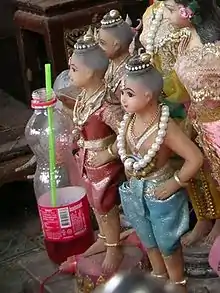Kuman Thong
Kuman Thong (Thai: กุมารทอง) is a household divinity of Thai folk religion. It is believed to bring luck and fortune to the owner if properly revered. Kuman, or Kumara (Pali) means "Sanctified young boy" (female kumari); thong means golden.
 Kuman Thong figures at a shrine in Ratchaburi Province | |
| Grouping | Tutelary deity |
|---|---|
| Sub grouping | Luck-bringing deity |
| Country | Thailand |
| Region | Southeast Asia |
Description
The veneration of Kuman Thong is not part of mainstream Buddhist practices, but it is popular in Thailand.
Origins
The authentic Kuman Thong originated in a practice of necromancy. They were obtained from the desiccated fetuses of children who had died whilst still in their mothers' womb. The witch doctors were said to have the power to invoke these stillborn babies, adopt them as their children, and use them to help them in their endeavours.
According to ancient Thai manuscripts used by practitioners of black magic (Thai: ไสยศาสตร์ Saiyasat), first the unborn fetus was surgically removed from the womb of its mother. Then the body of the child would be taken to a cemetery for the conduction of the proper ceremonial ritual to invoke a Kuman Thong. The body was roasted until dry whilst the witch doctor chanted incantations of magical script. Once the rite was completed, the dry-roasted Kuman was painted with Ya Lak (a kind of lacquer used to cover amulets and Takrut with gold leaf) and covered in gold leaf. Thus this effigy received the name of “Kuman Thong”, meaning “Golden Little Boy”.
Some Kuman effigies were soaked in Nam Man Phrai,[1] a kind of oil extracted by burning a candle close to the chin of a dead child or a person who died in violent circumstances or an unnatural death. This is much less common now, because this practice is now illegal if using fat from human babies for the consecrating oil. Occasionally there are still some amulets obtained through the authentic methods appearing in the market. Some years ago a famous monk was expelled from the Buddhist Sangha for roasting a baby. He was convicted, but later continued to make magic as a layperson after his release.[2]
Kuman Nee
In the case of a female spirit child, the effigy is not called Kuman Thong, but Kuman Nee
In literature
The Kuman Thong is mentioned in the Thai legend of Khun Chang Khun Phaen, where the character Khun Phaen made one by removing the stillborn baby from the stomach of his wife, whom he had killed.[3]
Recent events
On May 18, 2012 a 28-year-old British citizen of Taiwanese origin, Chow Hok Kuen, was arrested in a Bangkok hotel room with six male fetuses that had been roasted and covered in gold. Police reported that Kuen intended to sell the fetuses in Taiwan for about 6,300 USD each.[4][5][6]
In 2011, a case was reported in Laos of a man murdering his pregnant wife, so as to use the fetus as a "Louk Lord".[7]
Hyper-realistic dolls of children (but not made out of real children), "Luk Thep" or "Look Thep" ("child angel"),[8] have recently (2015) become popular in Thailand.[9][10][11][12][13] Some people believe the dolls can be injected with the spirit of a child after being blessed by a Buddhist monk. Their owners provide such care as food, water and clothes "in the hope of receiving good fortune in return", and some companies offer owners of the dolls the option to reserve them their own seats and services.[14]
See also
References
- "Sak Yant Buddhist Tattoos, Animist Magic, Spirit Possession, (E-Book), 2010, Spencer Littlewood". Archived from the original on 2013-01-29. Retrieved 2012-08-07.
- Farrell, James (6 June 2008). "The Hex, the Monk and the Exorcist". Chiangmai News (Vol 17). Archived from the original on 19 December 2014. Retrieved 19 December 2014.
- Williams, Alex (20 June 2013). "Thailand's ghastly wards: The magic of dead fetuses". Inside Investor. Retrieved 23 June 2013.
- Olarn, Kocha (18 May 2012). "In Thailand, roasted fetuses found stashed in luggage". CNN. Retrieved 19 May 2012.
- "Bangkok police arrest man accused of buying fetuses". The New York Post. 18 May 2012. Retrieved 19 May 2012.
- MacKinnon, Ian (18 May 2012). "Remains of six boys for black magic ritual found in suitcase". The Vancouver Sun. Retrieved 19 May 2012.
- http://www.news.com.au/breaking-news/man-killed-wife-for-lucky-lotto-feotus/story-e6frfku0-1225990638494
- "Superstition in Thailand: Dolls that bring luck—and drugs". The Economist. 30 January 2016. Retrieved 30 January 2016.
- http://audreymagazine.com/thailands-haunted-dolls-just-might-bring-you-luck/
- http://bangkok.coconuts.co/2015/05/22/all-cool-kids-are-worshiping-haunted-dolls-now
- http://bangkok.coconuts.co/2015/06/08/world-haunted-dolls-talk-child-god-doll-creator
- http://www.patheos.com/blogs/americanbuddhist/2015/09/buddhist-blessings-for-dolls-thailands-new-luck-charms.html
- http://www.smh.com.au/business/aviation/supernatural-dolls-can-buy-seats-on-thai-smile-airways-20160125-gmdu3j.html
- "Superstition in Thailand: Dolls that bring luck—and drugs". The Economist. 30 January 2016. Retrieved 30 January 2016.

